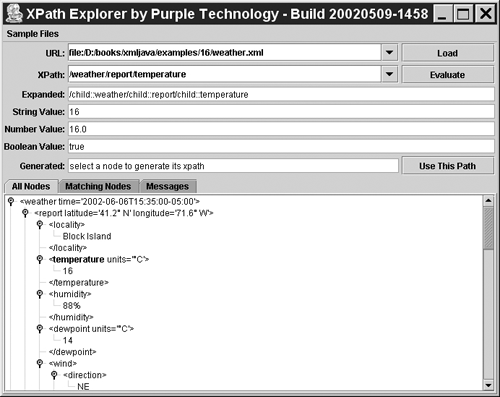Queries
| XPath can be thought of as a query language like SQL. Rather than extracting information from a database, however, XPath extracts information from an XML document. An example should help make this more concrete. Consider the simple weather report document in Example 16.1. Example 16.1 Weather Data in XML<?xml version="1.0" encoding="ISO-8859-1"?> <weather time="2002-06-06T15:35:00-05:00"> <report latitude="41.2 N" longitude="71.6 W"> <locality>Block Island</locality> <temperature units="C">16</temperature> <humidity>88%</humidity> <dewpoint units="C">14</dewpoint> <wind> <direction>NE</direction> <speed units="km/h">16.1</speed> <gust units="km/h">31</gust> </wind> <pressure units="hPa">1014</pressure> <condition>overcast</condition> <visibility>13 km</visibility> </report> <report latitude="34.1 N" longitude="118.4 W"> <locality>Santa Monica</locality> <temperature units="C">19</temperature> <humidity>79%</humidity> <dewpoint units="C">16</dewpoint> <wind> <direction>WSW</direction> <speed units="km/h">14.5</speed> </wind> <pressure units="hPa">1010</pressure> <condition>hazy</condition> <visibility>5 km</visibility> </report> </weather> Here are some XPath expressions that identify particular parts of this document:
Like SQL, XPath expressions are used in many different contexts, including the following:
|
EAN: 2147483647
Pages: 191
